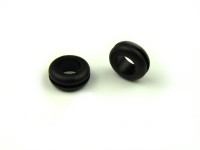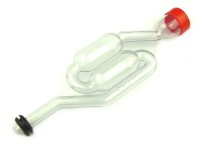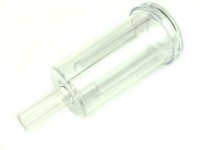Beer brewing with fermentation bung and rubber stopper
A fermentation bung (or fermentation tube) is a type of fermentation stopper. Such a fermentation bung is made of glass or plastic material and has a U-shape. The fermentation tube is located on a rubber stopper or cork. Fermentation tubes are mainly used in beer brewing, but can also be used for the Mashing wine be used for brewing. To use the fermentation bung, the mash vessel is closed with the tube and the rubber. So it is no longer possible for air or bacteria to get inside from the outside. If oxygen could get into the mash vessel, it would spread explosively in the mash and vinegar would be produced. Fortunately, the fermentation bung allows the gas (mainly carbon dioxide) released by the fermentation process to escape. This important benefit comes from the water trap present in the lower bend. Likewise, it prevents bacteria or insects from entering with the air into the Fermentation tank and thereby causing a faulty fermentation. This would cause spoilage of the mash.
Use during the main fermentation period
When the main fermentation period begins, the fermentation bung or glass tube should be filled with one third of water. The intensity of the gas emission can be used to reliably determine how far the fermentation process has progressed. Here you can also easily see fermentation stagnation as well as the end of fermentation. The fermentation tank should only be filled to about 80 percent. Otherwise, the fermentation foam, which is created by the carbonic acid, can form vinegar bacteria. Likewise, the outflow of the fermentation foam can cause contamination of the fermentation tank. The resulting must residues are then the breeding ground for bacteria. This results in a defective and unenjoyable beer. For this reason, the fermentation tank should never be filled to the brim, because then the dirt particles present in the fermenting material will also Brewer's yeast settle together at the bottom and are thus easy to remove. One speaks here on a so-called rising space, in which the foam accumulates and by the formation of carbonic acid thereby the air supply interrupts. The development of germs is also prevented.
Fermentation bung after the main fermentation period
After the main fermentation period, the fermentation bung can be filled with 2-6% sulfurous acid. The acid enables the exchange of sterile air, which is especially important in case of temperature or air pressure changes. If secondary fermentation occurs or acid biodegradation begins, it can be immediately detected by the appearance of bubbles in the fermentation bung. If the barrel container is not tapped, it is advantageous to keep it filled as much as possible. The sulfurous acid in the fermentation bung then ensures a sterile air supply to the inside of the keg container. This allows beer to be stored in a sterile state for a relatively long time without the contents going bad. However, the sulfurous acid must be replaced every 1-2 months during barrel storage to ensure a truly clean beer.
Fermentation bung for different barrels
We can supply you with fermentation bungs for different volume sizes. Brewmasters who only produce up to 60 liters of beer per brewing process should buy an appropriate fermentation bung. However, we also offer models for up to 120 liters and even up to 500 liters. When buying, pay attention to whether the fermentation tube comes with a rubber stopper. We also offer rubber stoppers separately in different sizes. So if a stopper should ever get lost or broken, you will always find the right size here. Just browse our store or contact us here , if you have questions about our fermentation tubes!















